Report on Health Inequalities: Intellectual Disability, Public Health
VerifiedAdded on 2020/04/29
|10
|4165
|382
Report
AI Summary
This report examines the health of individuals with intellectual disabilities, focusing on the Australian context. It begins with an introduction defining intellectual disability and its prevalence. The body of the report utilizes the Red Lotus Health Promotion Model to analyze health inequalities, exploring individual, environmental, and social determinants of health including biological factors (age, gender, ethnicity, genetics), socio-economic status, cognitive factors, and behaviors. The report discusses the influence of the natural, built, social, economic, and political environments on the health of this vulnerable population. It then proposes solutions based on the Ottawa Charter's action areas, considering social justice implications for future health professionals and multidisciplinary collaborations. The conclusion reflects on the multidisciplinary relevance of public health in addressing the complex needs of individuals with intellectual disabilities. References are provided in Vancouver style.
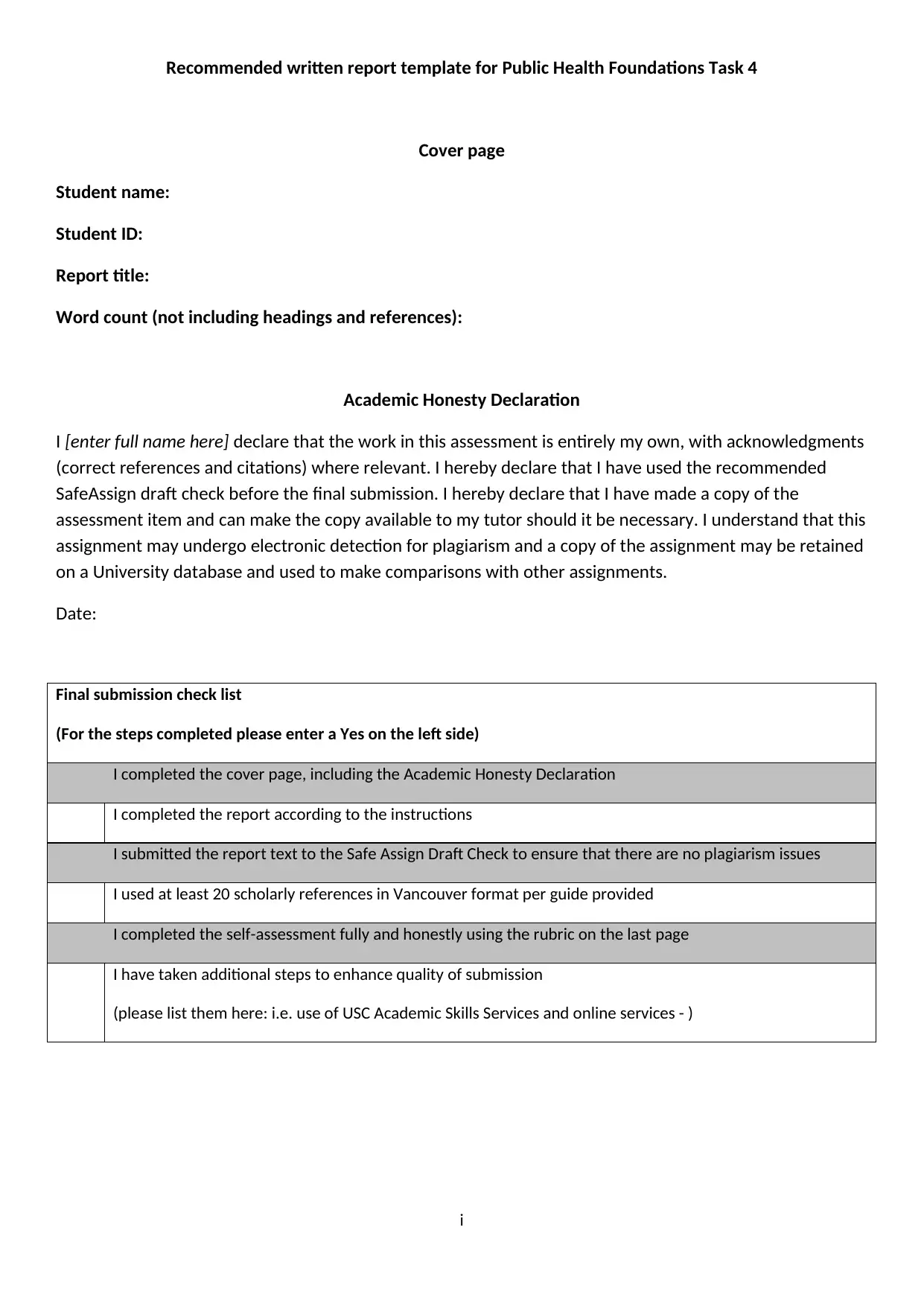
Recommended written report template for Public Health Foundations Task 4
Cover page
Student name:
Student ID:
Report title:
Word count (not including headings and references):
Academic Honesty Declaration
I [enter full name here] declare that the work in this assessment is entirely my own, with acknowledgments
(correct references and citations) where relevant. I hereby declare that I have used the recommended
SafeAssign draft check before the final submission. I hereby declare that I have made a copy of the
assessment item and can make the copy available to my tutor should it be necessary. I understand that this
assignment may undergo electronic detection for plagiarism and a copy of the assignment may be retained
on a University database and used to make comparisons with other assignments.
Date:
Final submission check list
(For the steps completed please enter a Yes on the left side)
I completed the cover page, including the Academic Honesty Declaration
I completed the report according to the instructions
I submitted the report text to the Safe Assign Draft Check to ensure that there are no plagiarism issues
I used at least 20 scholarly references in Vancouver format per guide provided
I completed the self-assessment fully and honestly using the rubric on the last page
I have taken additional steps to enhance quality of submission
(please list them here: i.e. use of USC Academic Skills Services and online services - )
i
Cover page
Student name:
Student ID:
Report title:
Word count (not including headings and references):
Academic Honesty Declaration
I [enter full name here] declare that the work in this assessment is entirely my own, with acknowledgments
(correct references and citations) where relevant. I hereby declare that I have used the recommended
SafeAssign draft check before the final submission. I hereby declare that I have made a copy of the
assessment item and can make the copy available to my tutor should it be necessary. I understand that this
assignment may undergo electronic detection for plagiarism and a copy of the assignment may be retained
on a University database and used to make comparisons with other assignments.
Date:
Final submission check list
(For the steps completed please enter a Yes on the left side)
I completed the cover page, including the Academic Honesty Declaration
I completed the report according to the instructions
I submitted the report text to the Safe Assign Draft Check to ensure that there are no plagiarism issues
I used at least 20 scholarly references in Vancouver format per guide provided
I completed the self-assessment fully and honestly using the rubric on the last page
I have taken additional steps to enhance quality of submission
(please list them here: i.e. use of USC Academic Skills Services and online services - )
i
Paraphrase This Document
Need a fresh take? Get an instant paraphrase of this document with our AI Paraphraser
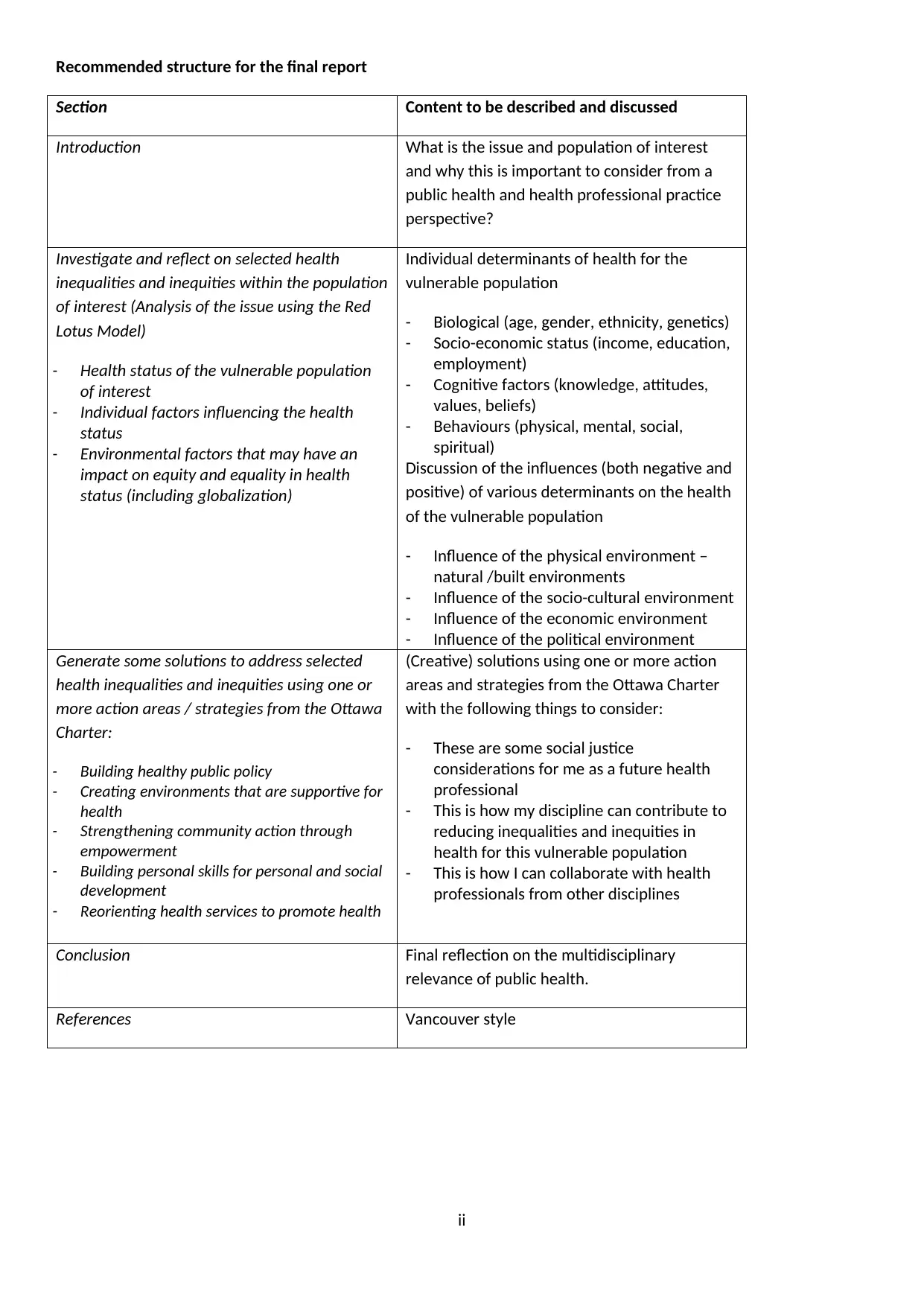
Recommended structure for the final report
Section Content to be described and discussed
Introduction What is the issue and population of interest
and why this is important to consider from a
public health and health professional practice
perspective?
Investigate and reflect on selected health
inequalities and inequities within the population
of interest (Analysis of the issue using the Red
Lotus Model)
- Health status of the vulnerable population
of interest
- Individual factors influencing the health
status
- Environmental factors that may have an
impact on equity and equality in health
status (including globalization)
Individual determinants of health for the
vulnerable population
- Biological (age, gender, ethnicity, genetics)
- Socio-economic status (income, education,
employment)
- Cognitive factors (knowledge, attitudes,
values, beliefs)
- Behaviours (physical, mental, social,
spiritual)
Discussion of the influences (both negative and
positive) of various determinants on the health
of the vulnerable population
- Influence of the physical environment –
natural /built environments
- Influence of the socio-cultural environment
- Influence of the economic environment
- Influence of the political environment
Generate some solutions to address selected
health inequalities and inequities using one or
more action areas / strategies from the Ottawa
Charter:
- Building healthy public policy
- Creating environments that are supportive for
health
- Strengthening community action through
empowerment
- Building personal skills for personal and social
development
- Reorienting health services to promote health
(Creative) solutions using one or more action
areas and strategies from the Ottawa Charter
with the following things to consider:
- These are some social justice
considerations for me as a future health
professional
- This is how my discipline can contribute to
reducing inequalities and inequities in
health for this vulnerable population
- This is how I can collaborate with health
professionals from other disciplines
Conclusion Final reflection on the multidisciplinary
relevance of public health.
References Vancouver style
ii
Section Content to be described and discussed
Introduction What is the issue and population of interest
and why this is important to consider from a
public health and health professional practice
perspective?
Investigate and reflect on selected health
inequalities and inequities within the population
of interest (Analysis of the issue using the Red
Lotus Model)
- Health status of the vulnerable population
of interest
- Individual factors influencing the health
status
- Environmental factors that may have an
impact on equity and equality in health
status (including globalization)
Individual determinants of health for the
vulnerable population
- Biological (age, gender, ethnicity, genetics)
- Socio-economic status (income, education,
employment)
- Cognitive factors (knowledge, attitudes,
values, beliefs)
- Behaviours (physical, mental, social,
spiritual)
Discussion of the influences (both negative and
positive) of various determinants on the health
of the vulnerable population
- Influence of the physical environment –
natural /built environments
- Influence of the socio-cultural environment
- Influence of the economic environment
- Influence of the political environment
Generate some solutions to address selected
health inequalities and inequities using one or
more action areas / strategies from the Ottawa
Charter:
- Building healthy public policy
- Creating environments that are supportive for
health
- Strengthening community action through
empowerment
- Building personal skills for personal and social
development
- Reorienting health services to promote health
(Creative) solutions using one or more action
areas and strategies from the Ottawa Charter
with the following things to consider:
- These are some social justice
considerations for me as a future health
professional
- This is how my discipline can contribute to
reducing inequalities and inequities in
health for this vulnerable population
- This is how I can collaborate with health
professionals from other disciplines
Conclusion Final reflection on the multidisciplinary
relevance of public health.
References Vancouver style
ii
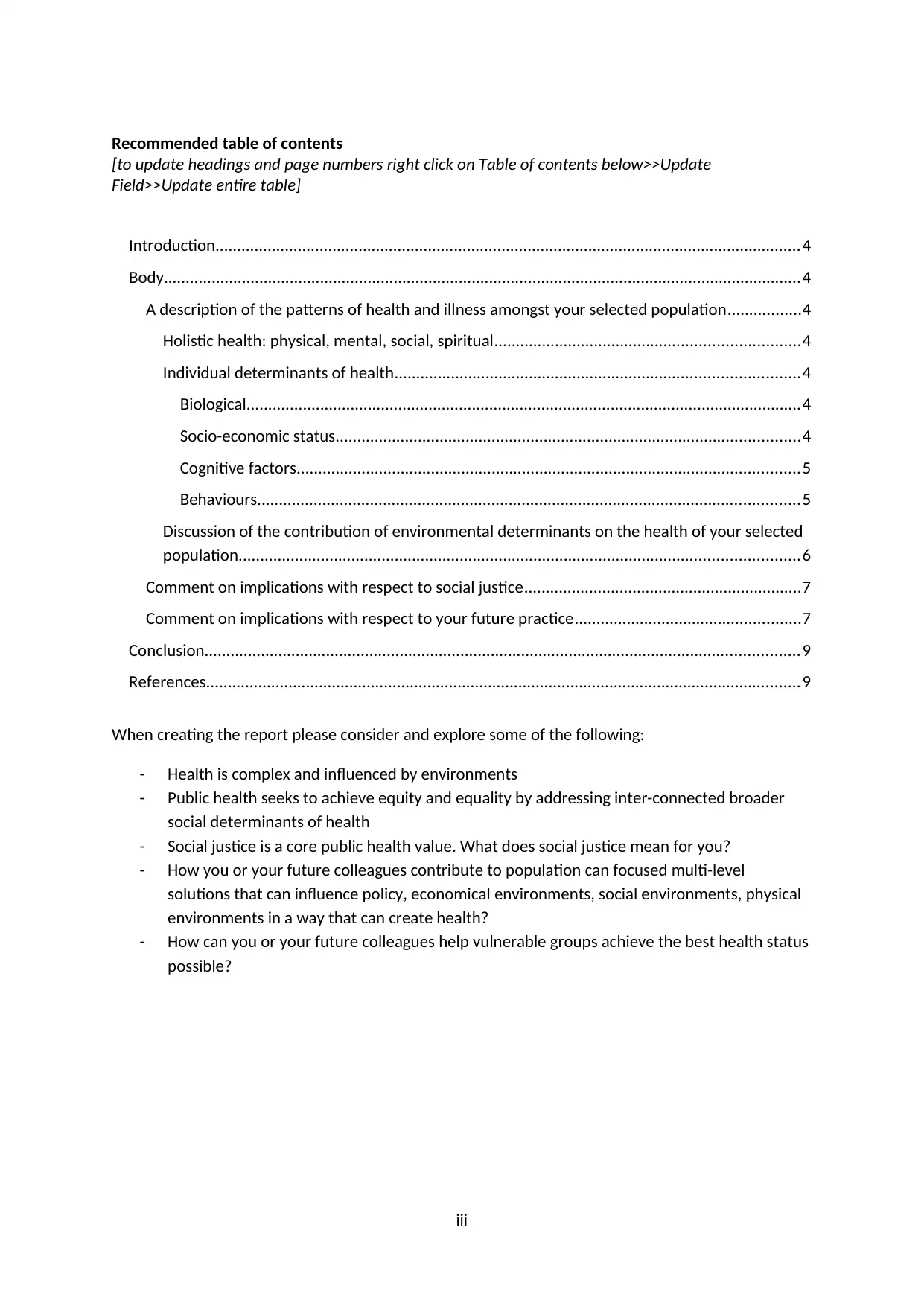
Recommended table of contents
[to update headings and page numbers right click on Table of contents below>>Update
Field>>Update entire table]
Introduction.......................................................................................................................................4
Body...................................................................................................................................................4
A description of the patterns of health and illness amongst your selected population.................4
Holistic health: physical, mental, social, spiritual......................................................................4
Individual determinants of health.............................................................................................4
Biological................................................................................................................................4
Socio-economic status...........................................................................................................4
Cognitive factors....................................................................................................................5
Behaviours.............................................................................................................................5
Discussion of the contribution of environmental determinants on the health of your selected
population.................................................................................................................................6
Comment on implications with respect to social justice................................................................7
Comment on implications with respect to your future practice....................................................7
Conclusion.........................................................................................................................................9
References.........................................................................................................................................9
When creating the report please consider and explore some of the following:
- Health is complex and influenced by environments
- Public health seeks to achieve equity and equality by addressing inter-connected broader
social determinants of health
- Social justice is a core public health value. What does social justice mean for you?
- How you or your future colleagues contribute to population can focused multi-level
solutions that can influence policy, economical environments, social environments, physical
environments in a way that can create health?
- How can you or your future colleagues help vulnerable groups achieve the best health status
possible?
iii
[to update headings and page numbers right click on Table of contents below>>Update
Field>>Update entire table]
Introduction.......................................................................................................................................4
Body...................................................................................................................................................4
A description of the patterns of health and illness amongst your selected population.................4
Holistic health: physical, mental, social, spiritual......................................................................4
Individual determinants of health.............................................................................................4
Biological................................................................................................................................4
Socio-economic status...........................................................................................................4
Cognitive factors....................................................................................................................5
Behaviours.............................................................................................................................5
Discussion of the contribution of environmental determinants on the health of your selected
population.................................................................................................................................6
Comment on implications with respect to social justice................................................................7
Comment on implications with respect to your future practice....................................................7
Conclusion.........................................................................................................................................9
References.........................................................................................................................................9
When creating the report please consider and explore some of the following:
- Health is complex and influenced by environments
- Public health seeks to achieve equity and equality by addressing inter-connected broader
social determinants of health
- Social justice is a core public health value. What does social justice mean for you?
- How you or your future colleagues contribute to population can focused multi-level
solutions that can influence policy, economical environments, social environments, physical
environments in a way that can create health?
- How can you or your future colleagues help vulnerable groups achieve the best health status
possible?
iii
⊘ This is a preview!⊘
Do you want full access?
Subscribe today to unlock all pages.

Trusted by 1+ million students worldwide
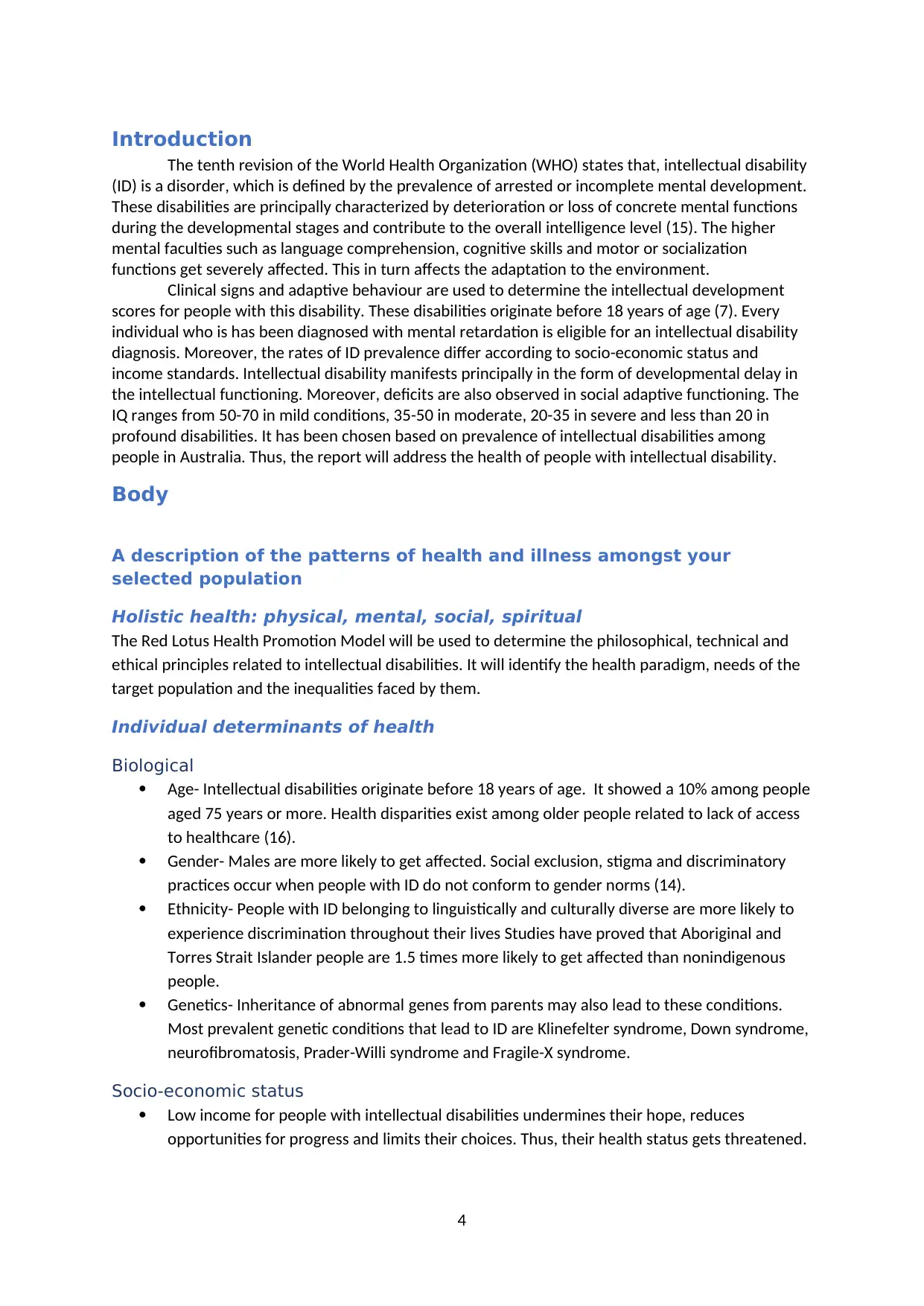
Introduction
The tenth revision of the World Health Organization (WHO) states that, intellectual disability
(ID) is a disorder, which is defined by the prevalence of arrested or incomplete mental development.
These disabilities are principally characterized by deterioration or loss of concrete mental functions
during the developmental stages and contribute to the overall intelligence level (15). The higher
mental faculties such as language comprehension, cognitive skills and motor or socialization
functions get severely affected. This in turn affects the adaptation to the environment.
Clinical signs and adaptive behaviour are used to determine the intellectual development
scores for people with this disability. These disabilities originate before 18 years of age (7). Every
individual who is has been diagnosed with mental retardation is eligible for an intellectual disability
diagnosis. Moreover, the rates of ID prevalence differ according to socio-economic status and
income standards. Intellectual disability manifests principally in the form of developmental delay in
the intellectual functioning. Moreover, deficits are also observed in social adaptive functioning. The
IQ ranges from 50-70 in mild conditions, 35-50 in moderate, 20-35 in severe and less than 20 in
profound disabilities. It has been chosen based on prevalence of intellectual disabilities among
people in Australia. Thus, the report will address the health of people with intellectual disability.
Body
A description of the patterns of health and illness amongst your
selected population
Holistic health: physical, mental, social, spiritual
The Red Lotus Health Promotion Model will be used to determine the philosophical, technical and
ethical principles related to intellectual disabilities. It will identify the health paradigm, needs of the
target population and the inequalities faced by them.
Individual determinants of health
Biological
Age- Intellectual disabilities originate before 18 years of age. It showed a 10% among people
aged 75 years or more. Health disparities exist among older people related to lack of access
to healthcare (16).
Gender- Males are more likely to get affected. Social exclusion, stigma and discriminatory
practices occur when people with ID do not conform to gender norms (14).
Ethnicity- People with ID belonging to linguistically and culturally diverse are more likely to
experience discrimination throughout their lives Studies have proved that Aboriginal and
Torres Strait Islander people are 1.5 times more likely to get affected than nonindigenous
people.
Genetics- Inheritance of abnormal genes from parents may also lead to these conditions.
Most prevalent genetic conditions that lead to ID are Klinefelter syndrome, Down syndrome,
neurofibromatosis, Prader-Willi syndrome and Fragile-X syndrome.
Socio-economic status
Low income for people with intellectual disabilities undermines their hope, reduces
opportunities for progress and limits their choices. Thus, their health status gets threatened.
4
The tenth revision of the World Health Organization (WHO) states that, intellectual disability
(ID) is a disorder, which is defined by the prevalence of arrested or incomplete mental development.
These disabilities are principally characterized by deterioration or loss of concrete mental functions
during the developmental stages and contribute to the overall intelligence level (15). The higher
mental faculties such as language comprehension, cognitive skills and motor or socialization
functions get severely affected. This in turn affects the adaptation to the environment.
Clinical signs and adaptive behaviour are used to determine the intellectual development
scores for people with this disability. These disabilities originate before 18 years of age (7). Every
individual who is has been diagnosed with mental retardation is eligible for an intellectual disability
diagnosis. Moreover, the rates of ID prevalence differ according to socio-economic status and
income standards. Intellectual disability manifests principally in the form of developmental delay in
the intellectual functioning. Moreover, deficits are also observed in social adaptive functioning. The
IQ ranges from 50-70 in mild conditions, 35-50 in moderate, 20-35 in severe and less than 20 in
profound disabilities. It has been chosen based on prevalence of intellectual disabilities among
people in Australia. Thus, the report will address the health of people with intellectual disability.
Body
A description of the patterns of health and illness amongst your
selected population
Holistic health: physical, mental, social, spiritual
The Red Lotus Health Promotion Model will be used to determine the philosophical, technical and
ethical principles related to intellectual disabilities. It will identify the health paradigm, needs of the
target population and the inequalities faced by them.
Individual determinants of health
Biological
Age- Intellectual disabilities originate before 18 years of age. It showed a 10% among people
aged 75 years or more. Health disparities exist among older people related to lack of access
to healthcare (16).
Gender- Males are more likely to get affected. Social exclusion, stigma and discriminatory
practices occur when people with ID do not conform to gender norms (14).
Ethnicity- People with ID belonging to linguistically and culturally diverse are more likely to
experience discrimination throughout their lives Studies have proved that Aboriginal and
Torres Strait Islander people are 1.5 times more likely to get affected than nonindigenous
people.
Genetics- Inheritance of abnormal genes from parents may also lead to these conditions.
Most prevalent genetic conditions that lead to ID are Klinefelter syndrome, Down syndrome,
neurofibromatosis, Prader-Willi syndrome and Fragile-X syndrome.
Socio-economic status
Low income for people with intellectual disabilities undermines their hope, reduces
opportunities for progress and limits their choices. Thus, their health status gets threatened.
4
Paraphrase This Document
Need a fresh take? Get an instant paraphrase of this document with our AI Paraphraser
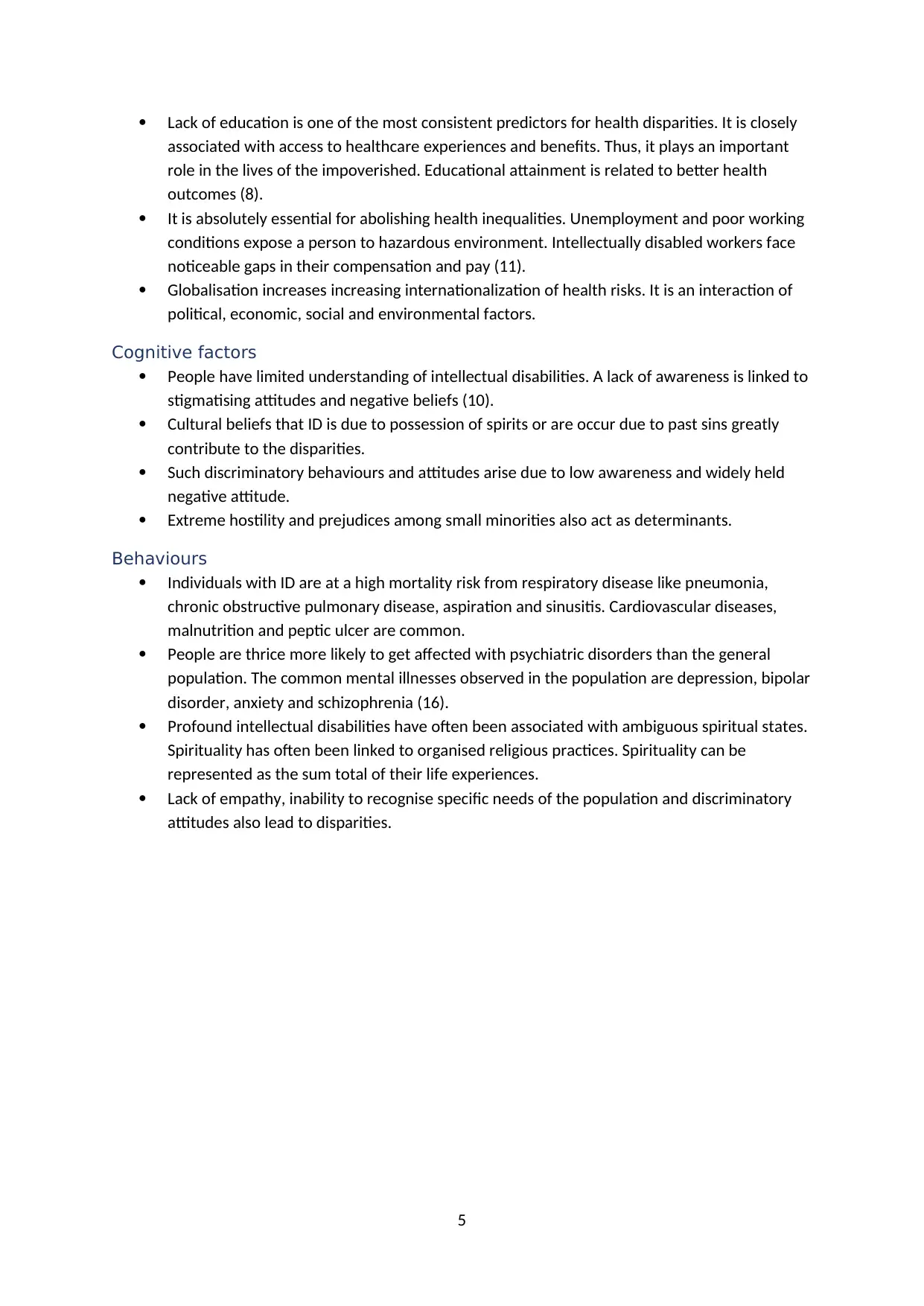
Lack of education is one of the most consistent predictors for health disparities. It is closely
associated with access to healthcare experiences and benefits. Thus, it plays an important
role in the lives of the impoverished. Educational attainment is related to better health
outcomes (8).
It is absolutely essential for abolishing health inequalities. Unemployment and poor working
conditions expose a person to hazardous environment. Intellectually disabled workers face
noticeable gaps in their compensation and pay (11).
Globalisation increases increasing internationalization of health risks. It is an interaction of
political, economic, social and environmental factors.
Cognitive factors
People have limited understanding of intellectual disabilities. A lack of awareness is linked to
stigmatising attitudes and negative beliefs (10).
Cultural beliefs that ID is due to possession of spirits or are occur due to past sins greatly
contribute to the disparities.
Such discriminatory behaviours and attitudes arise due to low awareness and widely held
negative attitude.
Extreme hostility and prejudices among small minorities also act as determinants.
Behaviours
Individuals with ID are at a high mortality risk from respiratory disease like pneumonia,
chronic obstructive pulmonary disease, aspiration and sinusitis. Cardiovascular diseases,
malnutrition and peptic ulcer are common.
People are thrice more likely to get affected with psychiatric disorders than the general
population. The common mental illnesses observed in the population are depression, bipolar
disorder, anxiety and schizophrenia (16).
Profound intellectual disabilities have often been associated with ambiguous spiritual states.
Spirituality has often been linked to organised religious practices. Spirituality can be
represented as the sum total of their life experiences.
Lack of empathy, inability to recognise specific needs of the population and discriminatory
attitudes also lead to disparities.
5
associated with access to healthcare experiences and benefits. Thus, it plays an important
role in the lives of the impoverished. Educational attainment is related to better health
outcomes (8).
It is absolutely essential for abolishing health inequalities. Unemployment and poor working
conditions expose a person to hazardous environment. Intellectually disabled workers face
noticeable gaps in their compensation and pay (11).
Globalisation increases increasing internationalization of health risks. It is an interaction of
political, economic, social and environmental factors.
Cognitive factors
People have limited understanding of intellectual disabilities. A lack of awareness is linked to
stigmatising attitudes and negative beliefs (10).
Cultural beliefs that ID is due to possession of spirits or are occur due to past sins greatly
contribute to the disparities.
Such discriminatory behaviours and attitudes arise due to low awareness and widely held
negative attitude.
Extreme hostility and prejudices among small minorities also act as determinants.
Behaviours
Individuals with ID are at a high mortality risk from respiratory disease like pneumonia,
chronic obstructive pulmonary disease, aspiration and sinusitis. Cardiovascular diseases,
malnutrition and peptic ulcer are common.
People are thrice more likely to get affected with psychiatric disorders than the general
population. The common mental illnesses observed in the population are depression, bipolar
disorder, anxiety and schizophrenia (16).
Profound intellectual disabilities have often been associated with ambiguous spiritual states.
Spirituality has often been linked to organised religious practices. Spirituality can be
represented as the sum total of their life experiences.
Lack of empathy, inability to recognise specific needs of the population and discriminatory
attitudes also lead to disparities.
5
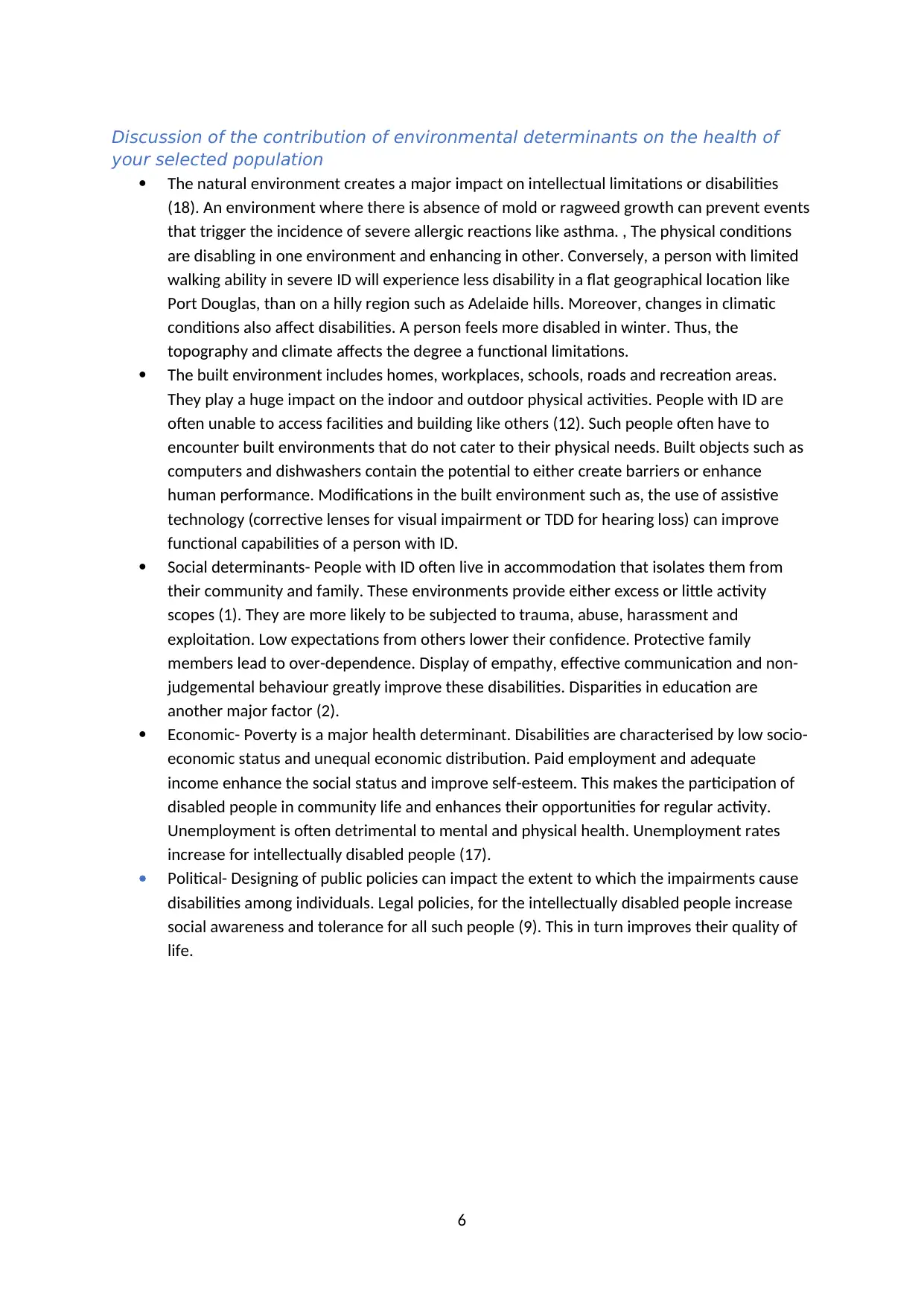
Discussion of the contribution of environmental determinants on the health of
your selected population
The natural environment creates a major impact on intellectual limitations or disabilities
(18). An environment where there is absence of mold or ragweed growth can prevent events
that trigger the incidence of severe allergic reactions like asthma. , The physical conditions
are disabling in one environment and enhancing in other. Conversely, a person with limited
walking ability in severe ID will experience less disability in a flat geographical location like
Port Douglas, than on a hilly region such as Adelaide hills. Moreover, changes in climatic
conditions also affect disabilities. A person feels more disabled in winter. Thus, the
topography and climate affects the degree a functional limitations.
The built environment includes homes, workplaces, schools, roads and recreation areas.
They play a huge impact on the indoor and outdoor physical activities. People with ID are
often unable to access facilities and building like others (12). Such people often have to
encounter built environments that do not cater to their physical needs. Built objects such as
computers and dishwashers contain the potential to either create barriers or enhance
human performance. Modifications in the built environment such as, the use of assistive
technology (corrective lenses for visual impairment or TDD for hearing loss) can improve
functional capabilities of a person with ID.
Social determinants- People with ID often live in accommodation that isolates them from
their community and family. These environments provide either excess or little activity
scopes (1). They are more likely to be subjected to trauma, abuse, harassment and
exploitation. Low expectations from others lower their confidence. Protective family
members lead to over-dependence. Display of empathy, effective communication and non-
judgemental behaviour greatly improve these disabilities. Disparities in education are
another major factor (2).
Economic- Poverty is a major health determinant. Disabilities are characterised by low socio-
economic status and unequal economic distribution. Paid employment and adequate
income enhance the social status and improve self-esteem. This makes the participation of
disabled people in community life and enhances their opportunities for regular activity.
Unemployment is often detrimental to mental and physical health. Unemployment rates
increase for intellectually disabled people (17).
Political- Designing of public policies can impact the extent to which the impairments cause
disabilities among individuals. Legal policies, for the intellectually disabled people increase
social awareness and tolerance for all such people (9). This in turn improves their quality of
life.
6
your selected population
The natural environment creates a major impact on intellectual limitations or disabilities
(18). An environment where there is absence of mold or ragweed growth can prevent events
that trigger the incidence of severe allergic reactions like asthma. , The physical conditions
are disabling in one environment and enhancing in other. Conversely, a person with limited
walking ability in severe ID will experience less disability in a flat geographical location like
Port Douglas, than on a hilly region such as Adelaide hills. Moreover, changes in climatic
conditions also affect disabilities. A person feels more disabled in winter. Thus, the
topography and climate affects the degree a functional limitations.
The built environment includes homes, workplaces, schools, roads and recreation areas.
They play a huge impact on the indoor and outdoor physical activities. People with ID are
often unable to access facilities and building like others (12). Such people often have to
encounter built environments that do not cater to their physical needs. Built objects such as
computers and dishwashers contain the potential to either create barriers or enhance
human performance. Modifications in the built environment such as, the use of assistive
technology (corrective lenses for visual impairment or TDD for hearing loss) can improve
functional capabilities of a person with ID.
Social determinants- People with ID often live in accommodation that isolates them from
their community and family. These environments provide either excess or little activity
scopes (1). They are more likely to be subjected to trauma, abuse, harassment and
exploitation. Low expectations from others lower their confidence. Protective family
members lead to over-dependence. Display of empathy, effective communication and non-
judgemental behaviour greatly improve these disabilities. Disparities in education are
another major factor (2).
Economic- Poverty is a major health determinant. Disabilities are characterised by low socio-
economic status and unequal economic distribution. Paid employment and adequate
income enhance the social status and improve self-esteem. This makes the participation of
disabled people in community life and enhances their opportunities for regular activity.
Unemployment is often detrimental to mental and physical health. Unemployment rates
increase for intellectually disabled people (17).
Political- Designing of public policies can impact the extent to which the impairments cause
disabilities among individuals. Legal policies, for the intellectually disabled people increase
social awareness and tolerance for all such people (9). This in turn improves their quality of
life.
6
⊘ This is a preview!⊘
Do you want full access?
Subscribe today to unlock all pages.

Trusted by 1+ million students worldwide

Comment on implications with respect to social justice
Social justice can be defined as equal distribution of opportunities and resources to all
people. It is a broad term and encompasses concepts of human equality and rights. I
consider social justice to be central to public health mission. It signifies a fair disbursement
of advantages and sharing of burdens (5). It captures the twin moral impulses that animate
public health: to advance human well-being by among all people. I intend to improve the
health of the intellectually disabled people by focusing on their needs. One of the biggest
obstacles is misconstruing access for health equity (18).
The future implications would include formulating public health policies, developing
personal skills, strengthening community actions and building supportive environment for
the target population (3). The existing policies and services related to disabilities will be
assessed. The priority areas will be identified. These priority areas would basically target
ensuring physical accessibility, creating awareness on disabilities and providing adequate
training to healthcare and community workers that will help them to recognise and meet the
demands of the people.
Health care standards will be established related to the care of the specific population.
These policies would make access to healthcare services easy for all sections of the society.
Strengthening the workforce will bring about improvements in healthcare and will better
address the poor health of people with ID. Community services will be strengthened to
enhance social support and self-help (4). Future strategies involve development of flexible
systems that will increase public participation. Mass-reach health interventions will increase
awareness among people.
Conducting community wide campaigns will also lead to modification of outdoor
recreational facilities and will enhance the access to places for physical activities. Teaching
social and personal skills to people with intellectual disability will help them take significant
steps towards their independence (6). Establishing skills training at homes or schools will
teach them how to cope with their disabilities and will further prepare them for the
surrounding environment.
Designing a cordial and supportive environment will help to meet the impairment needs of
the disabled people. A supportive environment will allow individuals with
moderate intellectual disabilities to master vocational and self-help skills with the assistance
of trained personnel (13). I wish to collaborate with other healthcare professionals for
bringing about these changes.
This is how my discipline will help me reduce health inequalities for this vulnerable
population. Thus, my future plans for promoting social justice among the intellectually
disabled people abide by the health promotion strategies of Ottawa Charter.
Comment on implications with respect to your future practice
I will seek help from my colleagues to bring about some changes in future to assist the
people with intellectual disabilities. I would promote emergency preparedness among the
target population to safeguard their health and lives. During calamities, disasters or at times
of emergency, people with intellectual disabilities are least likely to get evacuated. They
become especially vulnerable to the situations and can suffer to a great extent.
My plan for emergency preparedness would include planning for the various phases of
multiple disasters that could be man-made or natural. It would involve a system-level
7
Social justice can be defined as equal distribution of opportunities and resources to all
people. It is a broad term and encompasses concepts of human equality and rights. I
consider social justice to be central to public health mission. It signifies a fair disbursement
of advantages and sharing of burdens (5). It captures the twin moral impulses that animate
public health: to advance human well-being by among all people. I intend to improve the
health of the intellectually disabled people by focusing on their needs. One of the biggest
obstacles is misconstruing access for health equity (18).
The future implications would include formulating public health policies, developing
personal skills, strengthening community actions and building supportive environment for
the target population (3). The existing policies and services related to disabilities will be
assessed. The priority areas will be identified. These priority areas would basically target
ensuring physical accessibility, creating awareness on disabilities and providing adequate
training to healthcare and community workers that will help them to recognise and meet the
demands of the people.
Health care standards will be established related to the care of the specific population.
These policies would make access to healthcare services easy for all sections of the society.
Strengthening the workforce will bring about improvements in healthcare and will better
address the poor health of people with ID. Community services will be strengthened to
enhance social support and self-help (4). Future strategies involve development of flexible
systems that will increase public participation. Mass-reach health interventions will increase
awareness among people.
Conducting community wide campaigns will also lead to modification of outdoor
recreational facilities and will enhance the access to places for physical activities. Teaching
social and personal skills to people with intellectual disability will help them take significant
steps towards their independence (6). Establishing skills training at homes or schools will
teach them how to cope with their disabilities and will further prepare them for the
surrounding environment.
Designing a cordial and supportive environment will help to meet the impairment needs of
the disabled people. A supportive environment will allow individuals with
moderate intellectual disabilities to master vocational and self-help skills with the assistance
of trained personnel (13). I wish to collaborate with other healthcare professionals for
bringing about these changes.
This is how my discipline will help me reduce health inequalities for this vulnerable
population. Thus, my future plans for promoting social justice among the intellectually
disabled people abide by the health promotion strategies of Ottawa Charter.
Comment on implications with respect to your future practice
I will seek help from my colleagues to bring about some changes in future to assist the
people with intellectual disabilities. I would promote emergency preparedness among the
target population to safeguard their health and lives. During calamities, disasters or at times
of emergency, people with intellectual disabilities are least likely to get evacuated. They
become especially vulnerable to the situations and can suffer to a great extent.
My plan for emergency preparedness would include planning for the various phases of
multiple disasters that could be man-made or natural. It would involve a system-level
7
Paraphrase This Document
Need a fresh take? Get an instant paraphrase of this document with our AI Paraphraser
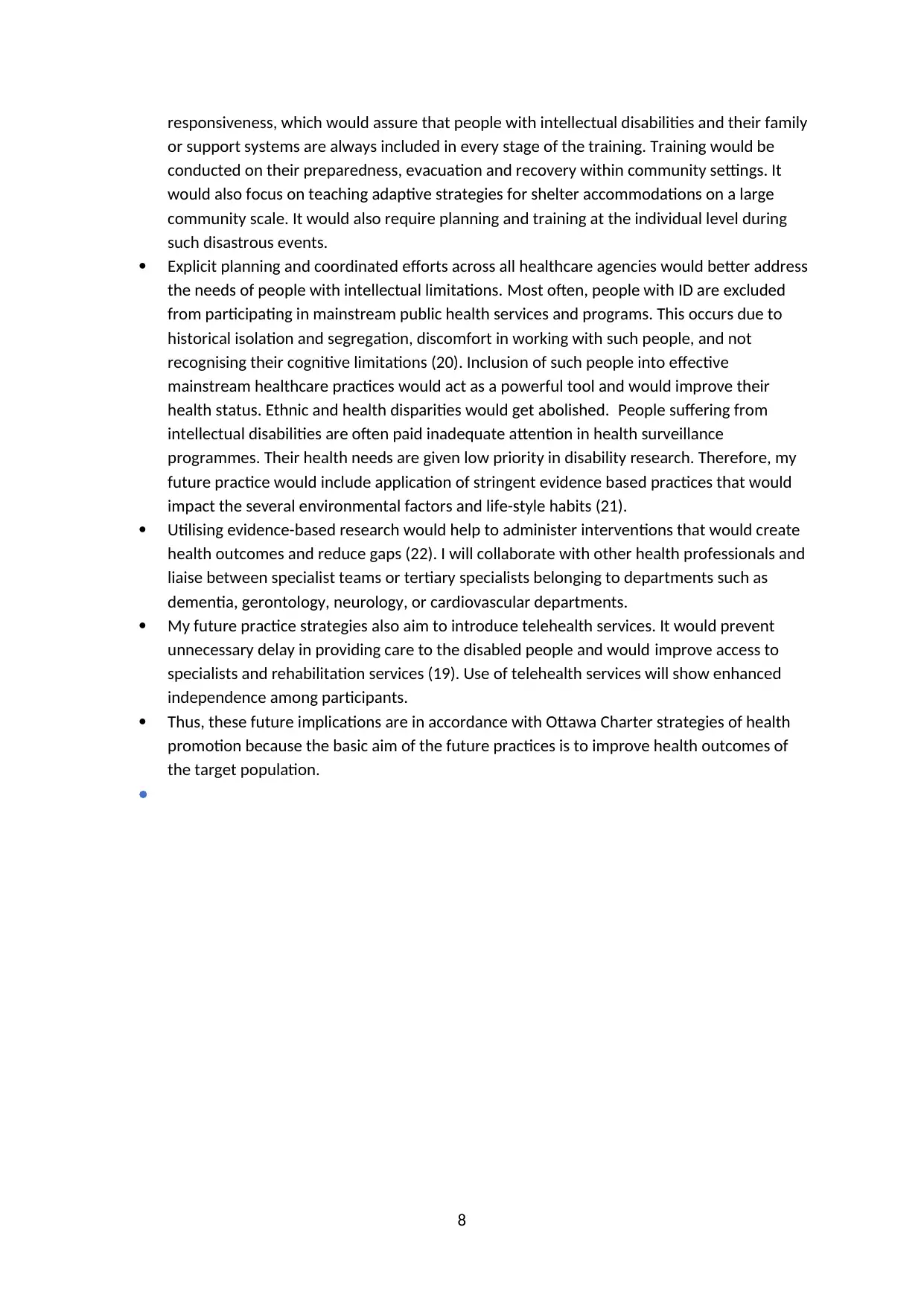
responsiveness, which would assure that people with intellectual disabilities and their family
or support systems are always included in every stage of the training. Training would be
conducted on their preparedness, evacuation and recovery within community settings. It
would also focus on teaching adaptive strategies for shelter accommodations on a large
community scale. It would also require planning and training at the individual level during
such disastrous events.
Explicit planning and coordinated efforts across all healthcare agencies would better address
the needs of people with intellectual limitations. Most often, people with ID are excluded
from participating in mainstream public health services and programs. This occurs due to
historical isolation and segregation, discomfort in working with such people, and not
recognising their cognitive limitations (20). Inclusion of such people into effective
mainstream healthcare practices would act as a powerful tool and would improve their
health status. Ethnic and health disparities would get abolished. People suffering from
intellectual disabilities are often paid inadequate attention in health surveillance
programmes. Their health needs are given low priority in disability research. Therefore, my
future practice would include application of stringent evidence based practices that would
impact the several environmental factors and life-style habits (21).
Utilising evidence-based research would help to administer interventions that would create
health outcomes and reduce gaps (22). I will collaborate with other health professionals and
liaise between specialist teams or tertiary specialists belonging to departments such as
dementia, gerontology, neurology, or cardiovascular departments.
My future practice strategies also aim to introduce telehealth services. It would prevent
unnecessary delay in providing care to the disabled people and would improve access to
specialists and rehabilitation services (19). Use of telehealth services will show enhanced
independence among participants.
Thus, these future implications are in accordance with Ottawa Charter strategies of health
promotion because the basic aim of the future practices is to improve health outcomes of
the target population.
8
or support systems are always included in every stage of the training. Training would be
conducted on their preparedness, evacuation and recovery within community settings. It
would also focus on teaching adaptive strategies for shelter accommodations on a large
community scale. It would also require planning and training at the individual level during
such disastrous events.
Explicit planning and coordinated efforts across all healthcare agencies would better address
the needs of people with intellectual limitations. Most often, people with ID are excluded
from participating in mainstream public health services and programs. This occurs due to
historical isolation and segregation, discomfort in working with such people, and not
recognising their cognitive limitations (20). Inclusion of such people into effective
mainstream healthcare practices would act as a powerful tool and would improve their
health status. Ethnic and health disparities would get abolished. People suffering from
intellectual disabilities are often paid inadequate attention in health surveillance
programmes. Their health needs are given low priority in disability research. Therefore, my
future practice would include application of stringent evidence based practices that would
impact the several environmental factors and life-style habits (21).
Utilising evidence-based research would help to administer interventions that would create
health outcomes and reduce gaps (22). I will collaborate with other health professionals and
liaise between specialist teams or tertiary specialists belonging to departments such as
dementia, gerontology, neurology, or cardiovascular departments.
My future practice strategies also aim to introduce telehealth services. It would prevent
unnecessary delay in providing care to the disabled people and would improve access to
specialists and rehabilitation services (19). Use of telehealth services will show enhanced
independence among participants.
Thus, these future implications are in accordance with Ottawa Charter strategies of health
promotion because the basic aim of the future practices is to improve health outcomes of
the target population.
8
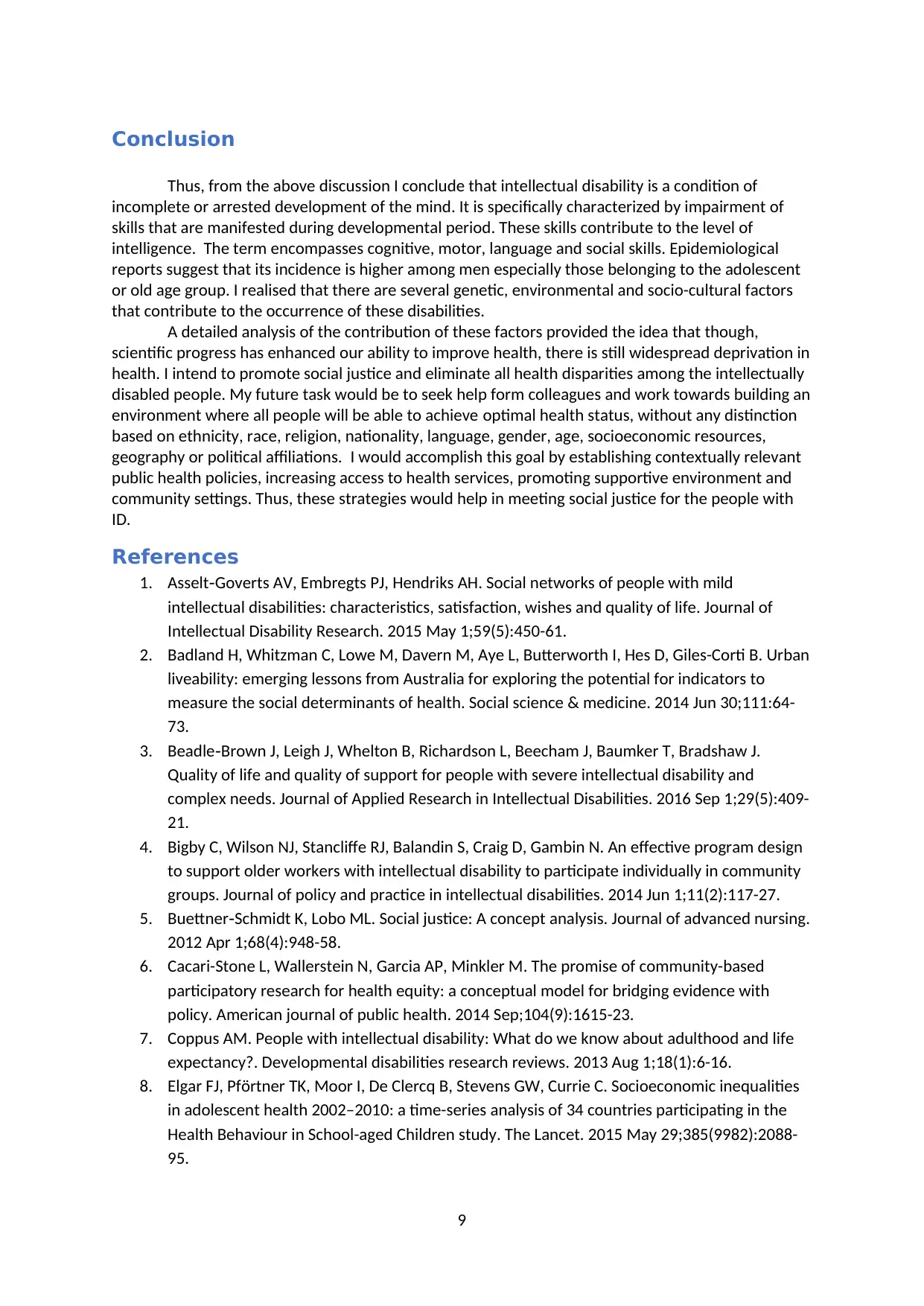
Conclusion
Thus, from the above discussion I conclude that intellectual disability is a condition of
incomplete or arrested development of the mind. It is specifically characterized by impairment of
skills that are manifested during developmental period. These skills contribute to the level of
intelligence. The term encompasses cognitive, motor, language and social skills. Epidemiological
reports suggest that its incidence is higher among men especially those belonging to the adolescent
or old age group. I realised that there are several genetic, environmental and socio-cultural factors
that contribute to the occurrence of these disabilities.
A detailed analysis of the contribution of these factors provided the idea that though,
scientific progress has enhanced our ability to improve health, there is still widespread deprivation in
health. I intend to promote social justice and eliminate all health disparities among the intellectually
disabled people. My future task would be to seek help form colleagues and work towards building an
environment where all people will be able to achieve optimal health status, without any distinction
based on ethnicity, race, religion, nationality, language, gender, age, socioeconomic resources,
geography or political affiliations. I would accomplish this goal by establishing contextually relevant
public health policies, increasing access to health services, promoting supportive environment and
community settings. Thus, these strategies would help in meeting social justice for the people with
ID.
References
1. Asselt Goverts AV, Embregts PJ, Hendriks AH. Social networks of people with mild‐
intellectual disabilities: characteristics, satisfaction, wishes and quality of life. Journal of
Intellectual Disability Research. 2015 May 1;59(5):450-61.
2. Badland H, Whitzman C, Lowe M, Davern M, Aye L, Butterworth I, Hes D, Giles-Corti B. Urban
liveability: emerging lessons from Australia for exploring the potential for indicators to
measure the social determinants of health. Social science & medicine. 2014 Jun 30;111:64-
73.
3. Beadle Brown J, Leigh J, Whelton B, Richardson L, Beecham J, Baumker T, Bradshaw J.‐
Quality of life and quality of support for people with severe intellectual disability and
complex needs. Journal of Applied Research in Intellectual Disabilities. 2016 Sep 1;29(5):409-
21.
4. Bigby C, Wilson NJ, Stancliffe RJ, Balandin S, Craig D, Gambin N. An effective program design
to support older workers with intellectual disability to participate individually in community
groups. Journal of policy and practice in intellectual disabilities. 2014 Jun 1;11(2):117-27.
5. Buettner Schmidt K, Lobo ML. Social justice: A concept analysis. Journal of advanced nursing.‐
2012 Apr 1;68(4):948-58.
6. Cacari-Stone L, Wallerstein N, Garcia AP, Minkler M. The promise of community-based
participatory research for health equity: a conceptual model for bridging evidence with
policy. American journal of public health. 2014 Sep;104(9):1615-23.
7. Coppus AM. People with intellectual disability: What do we know about adulthood and life
expectancy?. Developmental disabilities research reviews. 2013 Aug 1;18(1):6-16.
8. Elgar FJ, Pförtner TK, Moor I, De Clercq B, Stevens GW, Currie C. Socioeconomic inequalities
in adolescent health 2002–2010: a time-series analysis of 34 countries participating in the
Health Behaviour in School-aged Children study. The Lancet. 2015 May 29;385(9982):2088-
95.
9
Thus, from the above discussion I conclude that intellectual disability is a condition of
incomplete or arrested development of the mind. It is specifically characterized by impairment of
skills that are manifested during developmental period. These skills contribute to the level of
intelligence. The term encompasses cognitive, motor, language and social skills. Epidemiological
reports suggest that its incidence is higher among men especially those belonging to the adolescent
or old age group. I realised that there are several genetic, environmental and socio-cultural factors
that contribute to the occurrence of these disabilities.
A detailed analysis of the contribution of these factors provided the idea that though,
scientific progress has enhanced our ability to improve health, there is still widespread deprivation in
health. I intend to promote social justice and eliminate all health disparities among the intellectually
disabled people. My future task would be to seek help form colleagues and work towards building an
environment where all people will be able to achieve optimal health status, without any distinction
based on ethnicity, race, religion, nationality, language, gender, age, socioeconomic resources,
geography or political affiliations. I would accomplish this goal by establishing contextually relevant
public health policies, increasing access to health services, promoting supportive environment and
community settings. Thus, these strategies would help in meeting social justice for the people with
ID.
References
1. Asselt Goverts AV, Embregts PJ, Hendriks AH. Social networks of people with mild‐
intellectual disabilities: characteristics, satisfaction, wishes and quality of life. Journal of
Intellectual Disability Research. 2015 May 1;59(5):450-61.
2. Badland H, Whitzman C, Lowe M, Davern M, Aye L, Butterworth I, Hes D, Giles-Corti B. Urban
liveability: emerging lessons from Australia for exploring the potential for indicators to
measure the social determinants of health. Social science & medicine. 2014 Jun 30;111:64-
73.
3. Beadle Brown J, Leigh J, Whelton B, Richardson L, Beecham J, Baumker T, Bradshaw J.‐
Quality of life and quality of support for people with severe intellectual disability and
complex needs. Journal of Applied Research in Intellectual Disabilities. 2016 Sep 1;29(5):409-
21.
4. Bigby C, Wilson NJ, Stancliffe RJ, Balandin S, Craig D, Gambin N. An effective program design
to support older workers with intellectual disability to participate individually in community
groups. Journal of policy and practice in intellectual disabilities. 2014 Jun 1;11(2):117-27.
5. Buettner Schmidt K, Lobo ML. Social justice: A concept analysis. Journal of advanced nursing.‐
2012 Apr 1;68(4):948-58.
6. Cacari-Stone L, Wallerstein N, Garcia AP, Minkler M. The promise of community-based
participatory research for health equity: a conceptual model for bridging evidence with
policy. American journal of public health. 2014 Sep;104(9):1615-23.
7. Coppus AM. People with intellectual disability: What do we know about adulthood and life
expectancy?. Developmental disabilities research reviews. 2013 Aug 1;18(1):6-16.
8. Elgar FJ, Pförtner TK, Moor I, De Clercq B, Stevens GW, Currie C. Socioeconomic inequalities
in adolescent health 2002–2010: a time-series analysis of 34 countries participating in the
Health Behaviour in School-aged Children study. The Lancet. 2015 May 29;385(9982):2088-
95.
9
⊘ This is a preview!⊘
Do you want full access?
Subscribe today to unlock all pages.

Trusted by 1+ million students worldwide
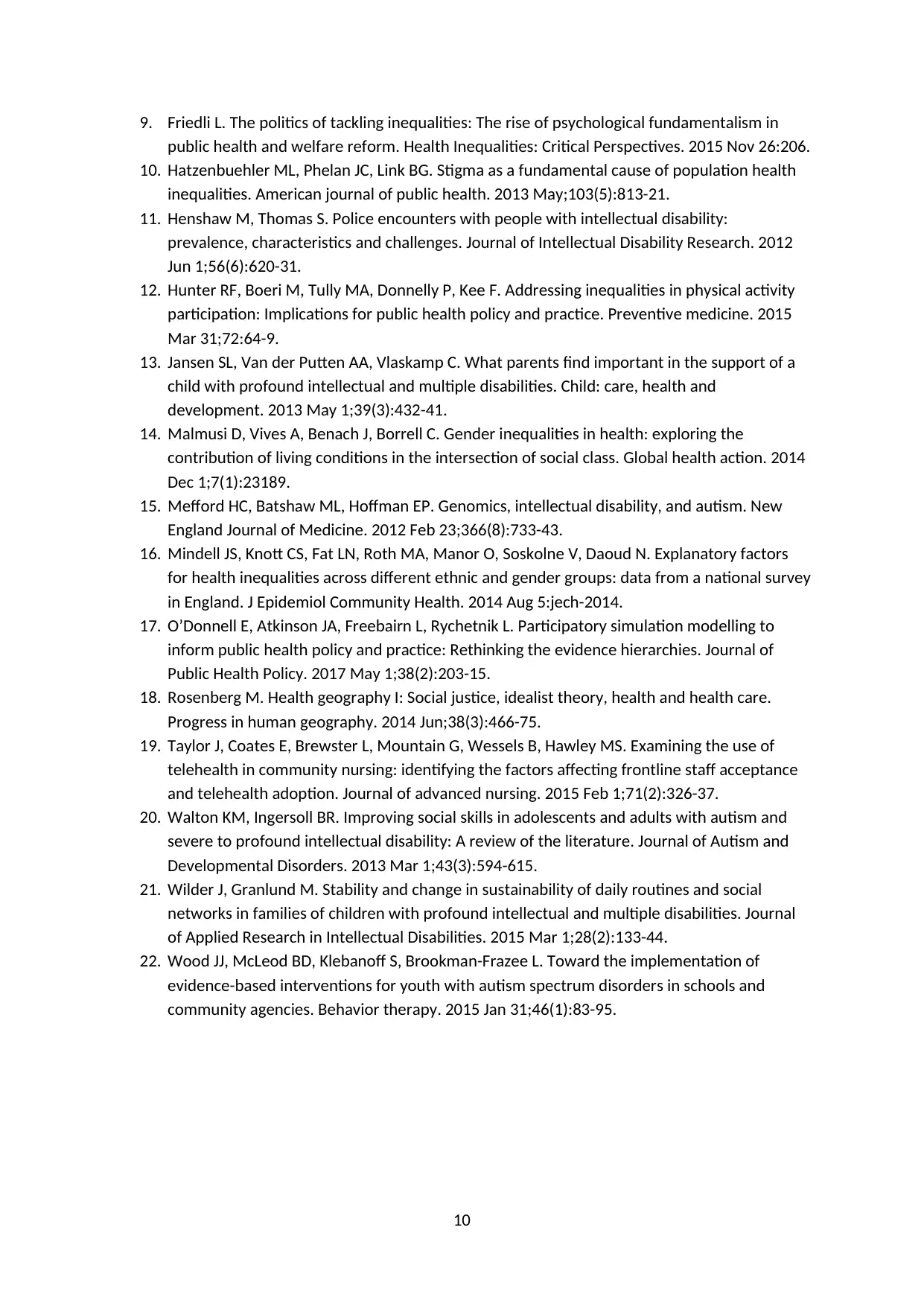
9. Friedli L. The politics of tackling inequalities: The rise of psychological fundamentalism in
public health and welfare reform. Health Inequalities: Critical Perspectives. 2015 Nov 26:206.
10. Hatzenbuehler ML, Phelan JC, Link BG. Stigma as a fundamental cause of population health
inequalities. American journal of public health. 2013 May;103(5):813-21.
11. Henshaw M, Thomas S. Police encounters with people with intellectual disability:
prevalence, characteristics and challenges. Journal of Intellectual Disability Research. 2012
Jun 1;56(6):620-31.
12. Hunter RF, Boeri M, Tully MA, Donnelly P, Kee F. Addressing inequalities in physical activity
participation: Implications for public health policy and practice. Preventive medicine. 2015
Mar 31;72:64-9.
13. Jansen SL, Van der Putten AA, Vlaskamp C. What parents find important in the support of a
child with profound intellectual and multiple disabilities. Child: care, health and
development. 2013 May 1;39(3):432-41.
14. Malmusi D, Vives A, Benach J, Borrell C. Gender inequalities in health: exploring the
contribution of living conditions in the intersection of social class. Global health action. 2014
Dec 1;7(1):23189.
15. Mefford HC, Batshaw ML, Hoffman EP. Genomics, intellectual disability, and autism. New
England Journal of Medicine. 2012 Feb 23;366(8):733-43.
16. Mindell JS, Knott CS, Fat LN, Roth MA, Manor O, Soskolne V, Daoud N. Explanatory factors
for health inequalities across different ethnic and gender groups: data from a national survey
in England. J Epidemiol Community Health. 2014 Aug 5:jech-2014.
17. O’Donnell E, Atkinson JA, Freebairn L, Rychetnik L. Participatory simulation modelling to
inform public health policy and practice: Rethinking the evidence hierarchies. Journal of
Public Health Policy. 2017 May 1;38(2):203-15.
18. Rosenberg M. Health geography I: Social justice, idealist theory, health and health care.
Progress in human geography. 2014 Jun;38(3):466-75.
19. Taylor J, Coates E, Brewster L, Mountain G, Wessels B, Hawley MS. Examining the use of
telehealth in community nursing: identifying the factors affecting frontline staff acceptance
and telehealth adoption. Journal of advanced nursing. 2015 Feb 1;71(2):326-37.
20. Walton KM, Ingersoll BR. Improving social skills in adolescents and adults with autism and
severe to profound intellectual disability: A review of the literature. Journal of Autism and
Developmental Disorders. 2013 Mar 1;43(3):594-615.
21. Wilder J, Granlund M. Stability and change in sustainability of daily routines and social
networks in families of children with profound intellectual and multiple disabilities. Journal
of Applied Research in Intellectual Disabilities. 2015 Mar 1;28(2):133-44.
22. Wood JJ, McLeod BD, Klebanoff S, Brookman-Frazee L. Toward the implementation of
evidence-based interventions for youth with autism spectrum disorders in schools and
community agencies. Behavior therapy. 2015 Jan 31;46(1):83-95.
10
public health and welfare reform. Health Inequalities: Critical Perspectives. 2015 Nov 26:206.
10. Hatzenbuehler ML, Phelan JC, Link BG. Stigma as a fundamental cause of population health
inequalities. American journal of public health. 2013 May;103(5):813-21.
11. Henshaw M, Thomas S. Police encounters with people with intellectual disability:
prevalence, characteristics and challenges. Journal of Intellectual Disability Research. 2012
Jun 1;56(6):620-31.
12. Hunter RF, Boeri M, Tully MA, Donnelly P, Kee F. Addressing inequalities in physical activity
participation: Implications for public health policy and practice. Preventive medicine. 2015
Mar 31;72:64-9.
13. Jansen SL, Van der Putten AA, Vlaskamp C. What parents find important in the support of a
child with profound intellectual and multiple disabilities. Child: care, health and
development. 2013 May 1;39(3):432-41.
14. Malmusi D, Vives A, Benach J, Borrell C. Gender inequalities in health: exploring the
contribution of living conditions in the intersection of social class. Global health action. 2014
Dec 1;7(1):23189.
15. Mefford HC, Batshaw ML, Hoffman EP. Genomics, intellectual disability, and autism. New
England Journal of Medicine. 2012 Feb 23;366(8):733-43.
16. Mindell JS, Knott CS, Fat LN, Roth MA, Manor O, Soskolne V, Daoud N. Explanatory factors
for health inequalities across different ethnic and gender groups: data from a national survey
in England. J Epidemiol Community Health. 2014 Aug 5:jech-2014.
17. O’Donnell E, Atkinson JA, Freebairn L, Rychetnik L. Participatory simulation modelling to
inform public health policy and practice: Rethinking the evidence hierarchies. Journal of
Public Health Policy. 2017 May 1;38(2):203-15.
18. Rosenberg M. Health geography I: Social justice, idealist theory, health and health care.
Progress in human geography. 2014 Jun;38(3):466-75.
19. Taylor J, Coates E, Brewster L, Mountain G, Wessels B, Hawley MS. Examining the use of
telehealth in community nursing: identifying the factors affecting frontline staff acceptance
and telehealth adoption. Journal of advanced nursing. 2015 Feb 1;71(2):326-37.
20. Walton KM, Ingersoll BR. Improving social skills in adolescents and adults with autism and
severe to profound intellectual disability: A review of the literature. Journal of Autism and
Developmental Disorders. 2013 Mar 1;43(3):594-615.
21. Wilder J, Granlund M. Stability and change in sustainability of daily routines and social
networks in families of children with profound intellectual and multiple disabilities. Journal
of Applied Research in Intellectual Disabilities. 2015 Mar 1;28(2):133-44.
22. Wood JJ, McLeod BD, Klebanoff S, Brookman-Frazee L. Toward the implementation of
evidence-based interventions for youth with autism spectrum disorders in schools and
community agencies. Behavior therapy. 2015 Jan 31;46(1):83-95.
10
1 out of 10
Your All-in-One AI-Powered Toolkit for Academic Success.
+13062052269
info@desklib.com
Available 24*7 on WhatsApp / Email
![[object Object]](/_next/static/media/star-bottom.7253800d.svg)
Unlock your academic potential
Copyright © 2020–2026 A2Z Services. All Rights Reserved. Developed and managed by ZUCOL.

